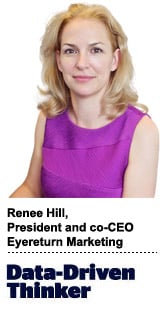 “Data-Driven Thinking” is written by members of the media community and contains fresh ideas on the digital revolution in media.
“Data-Driven Thinking” is written by members of the media community and contains fresh ideas on the digital revolution in media.
Today’s column is written by Renee Hill, president and co-CEO at Eyereturn Marketing.
The WSJ recently examined Google’s seemingly under-the-radar transition from search information conduit 10 years ago to full-fledged content- and commerce-driven destination today.
Pre-IPO, Google was a successful tool to push online users to brand sites, but now, more than ever, this search engine keeps those same users on its own sites by offering content that is at least as good – if not better – than what advertisers’ paid search results provide.
For example, if you search for Tesla’s stock symbol, TSLA, Google presents the share price directly in the search results. Immediately beneath the chart, the first link leads to Google Finance, where all of the stocks statistics are presented, in addition to a summary of all relevant business news concerning the stock. Historically, the user would have ended up on a business news site, such as Stockhouse or Financial Post, but with Google’s interception, this user will likely find out what they were after and remain on Google.
This dovetails nicely with another example of Google disintermediating a site or brand: Google News. Through the “fair use” principle, Google programmatically curates and summarizes news stories from around the world for consumers in Google’s News App and directly under Google’s “News” tab. Users searching for “Obama” are presented fair-use summaries of a variety of publishers’ content in the search results page, with the page’s top link leading directly to Google News.
Google is not alone in its attempts to own the user and their experience. Facebook designed its own ecosystem to draw users in and not let them leave, for example, by creating product- and brand-specific pages inside Facebook. Only approved advertisers with mighty budgets are permitted to run ads that lead users outside of Facebook.
Even in these cases, Facebook advertisers are not permitted to use independent ad servers, and therefore must rely exclusively on Facebook’s technology to target and serve ad and determine viewability and conversion rates. It’s a highly controlled and closed system, akin to a black hole where data enters and mostly never leaves.
Amazon, too, has recently begun offering ad agencies self-serve tools to buy advertising on its network, with a singular focus on becoming the go-to shopping platform of the web. A concerning pattern is evident.
When large platforms like Google and Facebook control the who, what, where, why and when of a consumer, everybody else must play within the platform’s rules.
Who: Consumers who use these large platforms all share who they are and their interests, supplying valuable information about their preferences and demographic profile.
What: The platform knows the person interests, surfing habits, likes and dislikes.
Where: The platform knows where the consumer is located physically, either by their IP address, mobile phone location or cross-device targeting.
When and why: With all of this data, these platforms use predictive algorithms to figure out what drives specific consumer behavior, as well as consumer behavior as a whole.
The net effect is unprecedented access to user data and behavior. Knowing the who, what, where, why and when gives them total control of an ecosystem.
These few dominant platforms keep consumers in their ecosystem. The moment you become an Amazon consumer, it applies data to every user click, guiding a consumer’s experience and showcasing other products you may like. Google does the same thing, but it has an even wider net. It is able to understand consumer behavior not only by their search engine and content, but additionally because it is also a publisher ad server (DART for Publishers) and an advertiser ad server (DART for Advertisers).
By controlling these ad servers, it tracks users’ behavior across the majority of websites and for the majority of advertisers. This is then layered into Google+ data, YouTube data, historical search data and location data. While advertisers think this end-to-end system gives them unprecedented access to data about their consumer, they don’t realize they’ve stopped informing their business about the habits and trends of their consumer and have handed over control of their business to the platform.
Now that Google offers price comparisons within search, it has effectively eliminated the use for a retail brand to showcase products or even to have a website at all. Google becomes the company that can react and capitalize on trends. As search results become more biased, Google can promote whatever companies prove to be the most profitable to Google. This fundamental shift in promotional power places the brands at the mercy of Google. Google can choose to feature certain products or not.
The result: less traffic to advertisers’ sites, loss of customers and destruction of brands.
Advertisers feel the brunt of this “Google Effect,” especially companies in the online travel agency and retail sectors, which, ironically, were so heavily invested in Google and helped it to grow to its current market-leading position.
Looking ahead, Google’s path leads solidly upward unless the marketplace takes a stand. Google ad revenues continue to grow year over year, and the more they squeeze paid advertisers to share content, the greater the chance that this trend will only continue, making Google a destination site vs. an unbiased search engine that it once purported to be.
Advertisers and the industry are in trouble if platforms like Google become the only option. As companies like Google monopolize the DSP, search and ad serving arenas, advertisers will have no choice. Yes, the initial discount prices offered by such companies is enticing, but how long will these rates last and at what cost? The future could see little to no conversions and an ecosystem where providers set the margins.
The Google Effect represents a cautionary tale about monopolies: Companies should question how much information they are required to provide in order to work with a major platform. They should be concerned about what other options will be out there for online marketing – without Google or the next giant tech firm – if we continue to allow their infiltration into all aspects of the online ecosystem.
Follow Renee Hill (@ReneeNHill), Eyereturn Marketing (@eyeReturnMktg) and AdExchanger (@adexchanger) on Twitter.













